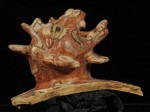 A team of archaeologists from Brown University has found an incredibly well-preserved Maya royal tomb beneath the El Diablo pyramid in the archaeological site of El Zotz, in northern Guatemala. The tomb dates to between 350 and 400 A.D., but despite its venerable 1600 years of age, it was so well-sealed that when archaeologists opened the tomb it still smelled of decaying bodies.
A team of archaeologists from Brown University has found an incredibly well-preserved Maya royal tomb beneath the El Diablo pyramid in the archaeological site of El Zotz, in northern Guatemala. The tomb dates to between 350 and 400 A.D., but despite its venerable 1600 years of age, it was so well-sealed that when archaeologists opened the tomb it still smelled of decaying bodies.
The tomb was sealed by layers of mud and stone, which kept the tomb safe from human and environmental ravages. The airtight and nearly watertight conditions have preserved the contents, including organic artifacts like carved wood, rope and textiles that rarely survive. There’s also richly decorated pottery and bowls containing finger bones.
It appears the tomb held an adult male, but the bone analyst, Andrew Scherer, assistant professor of anthropology at Brown, has not yet confirmed the finding. So far, it seems likely that there are six children in the tomb, some with whole bodies and probably two solely with skulls.
And who was this man? Though the findings are still very new, the group believes the tomb is likely from a king they only know about from other hieroglyphic texts — one of [team leader Stephen] Houston’s specialties in Maya archaeology. “These items are artistic riches, extraordinarily preserved from a key time in Maya history,” said Houston. “From the tomb’s position, time, richness, and repeated constructions atop the tomb, we believe this is very likely the founder of a dynasty.”
Houston says the tomb shows that the ruler is going into the tomb as a ritual dancer. He has all the attributes of this role, including many small ‘bells’ of shell with, probably, dog canines as clappers. “There is a chance too, that his body, which rested on a raised bier that collapsed to the floor, had an elaborate headdress with small glyphs on them. One of his hands may have held a sacrificial blade.”
There’s a red organic substance on the blade. It hasn’t been analyzed yet, but the stone expert notes that the style of blade is the kind used to cut through bone and other hard materials, so Houston feels safe in positing that the red substance is blood.
The team made this find early in the expedition — they’ve only been on site a few weeks — and there’s much left to do, especially given the complexity of royal tombs and the particular bounty of this undisturbed one.